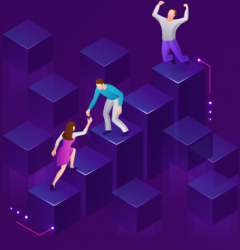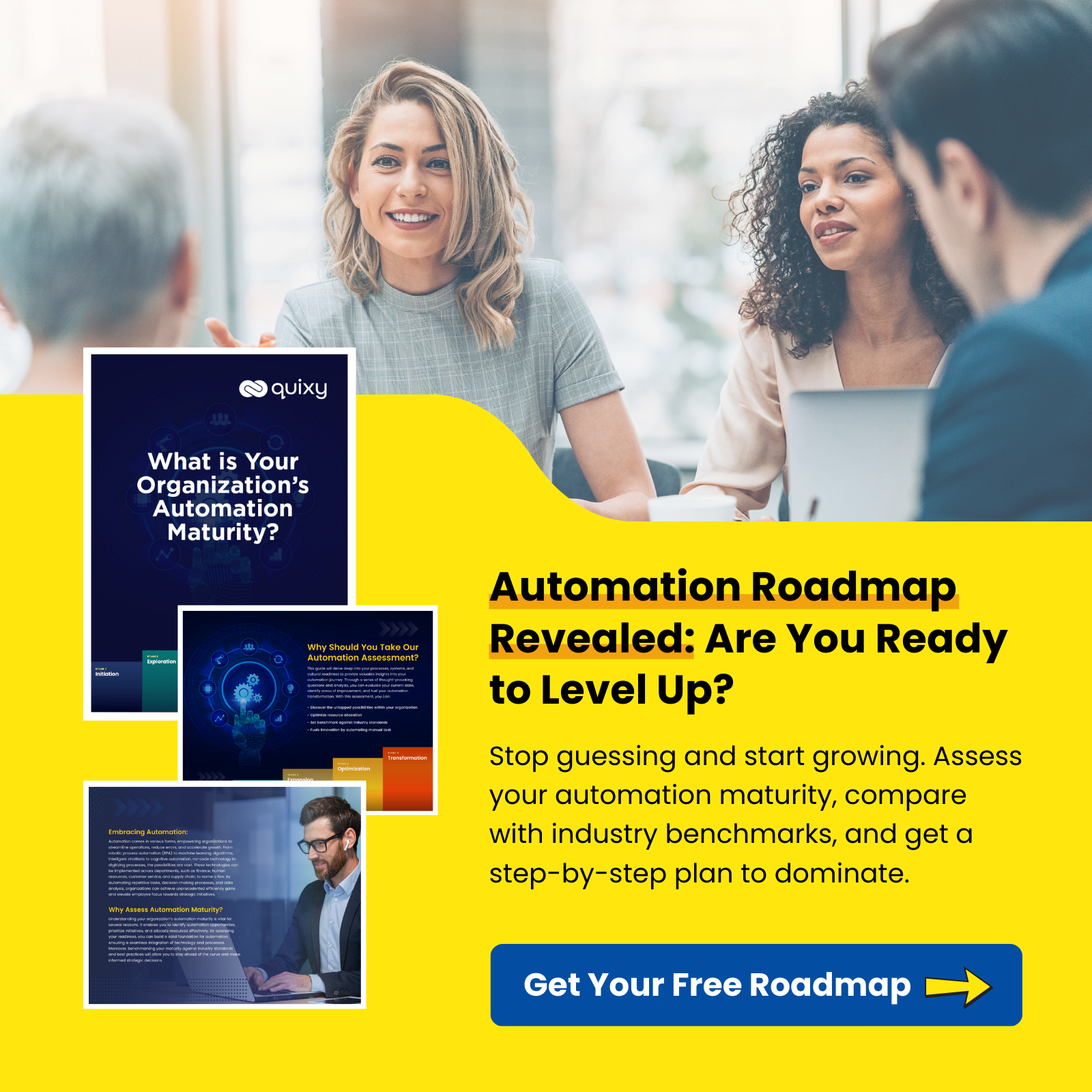
Digital dexterity is omnipresent, especially in the current technological landscape. With technology enabling you to order a pizza and get it delivered fast, go online shopping with your favorite e-commerce platform, or use social media to stay updated on your friends and family, digital competency and dexterity have practically become life skills.
Employees at organizations need to pay special attention to keeping up with technological innovations to take advantage of them before their competitors get to them. This makes it important for every employee to be digitally dexterous which can also encourage a smoother digital transformation on the whole.
In this blog, we’ll discuss the basics of digital dexterity, its associated qualities, its benefits, and the points that can help you achieve digital dexterity at the workplace.
What is digital dexterity?
Digital dexterity is the ability of employees to adapt and adopt existing and emerging technologies in their field to produce better results for their company. As the digital world is constantly changing, the desire to adapt and innovate using new technologies is important for employees. The level of digital dexterity can affect both the employees and the organization. Digital change needs to be welcomed and this shift in mindset needs to be seen in each individual employee as well on an organizational level. An agile and flexible team can make all the difference when implementing a digital transformation; this is where digital dexterity comes in.
Digital dexterity is the ability of employees to adapt and adopt existing and emerging technologies in their field to produce better results for their company.
Digital transformation is an increasingly popular buzzword nowadays and having digital dexterity, your employees can definitely bring about this change faster. When your formal, political, and cultural systems change in a way that is digitally inclined, this transformation can happen effectively and rapidly. A digitally forward business is more agile, open to change, and ready to adopt new technologies, leading to a wealth of benefits for the company on the whole. Digital dexterity in the workforce keeps your employees on their toes and ready to embrace the next best innovation or new technology.
In many organizations, the HR department is responsible for the introduction of new policies and systems. This puts them in the ideal place to introduce a digital forward mindset in the company, however, they cannot be responsible for the change entirely. Every employee needs to be inclined towards a digital transformation for the new systems to work out. As the overall business landscape has changed, there has been a large-scale introduction of useful digital tools that are now being used on a daily basis. The adoption of these tools and the ability to create strategies around their features can be influenced by encouraging digital dexterity amongst your employees.
Also read: Digital Leadership in a New Era and How Workplace Culture Matters More Than Ever
What are the qualities associated with digital dexterity?
Digital dexterity is a method of priming your organization for future problems and finding solutions using digital tools. This is often an organization-wide mindset that can help employees become more knowledgeable about digital tools and features. As Rashmi Choudhary, principal research analyst at Gartner, says “Going forward, the dependence on technology to promote collaboration and a sense of belonging so that remote workers stay connected and engaged in the ‘new normal’ will be more important than it has ever been before.” Thus, digital dexterity and its qualities have become more and more essential as time has passed.
Going forward, the dependence on technology to promote collaboration and a sense of belonging so that remote workers stay connected and engaged in the ‘new normal’ will be more important than it has ever been before.
Rashmi Choudhary, principal research analyst at Gartner
Here are a few qualities of employees and organizations who are inclined towards digital dexterity:
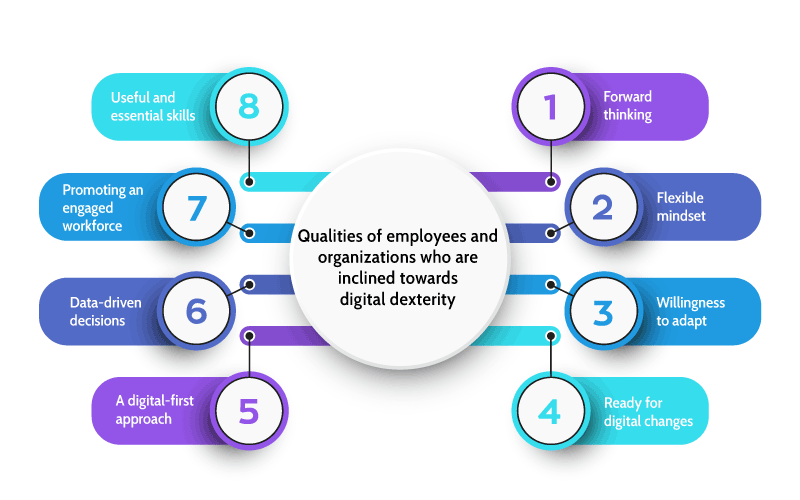
1. Forward-thinking
Employees need to understand that they are developing skills and switching to a digital mindset to promote changes in the future in the company. If the individual thinks for the future, they can better grasp future problems and how to start solving them in the present.
2. Flexible mindset
Digital dexterity requires a flexible mindset as the technological landscape is always changing. With new technologies being introduced practically every day, employees can’t remain digitally inclined unless they are flexible and open to using new solutions.
3. Willingness to adapt
Each new software and technology on the market brings its own set of advantages and disadvantages. An employee needs to be ready to adapt to any new software introduced to them and leverage the unique functionalities to provide the most value to the organization. If employees become stuck in their ways, they won’t be able to adapt at the needed pace.
4. Ready for digital changes
Considering the new advent of no-code tools, the age-old coding practice is also becoming less of a barrier to allowing nontechnical people to create the needed applications. Digital changes are happening constantly, and employees need to be on the lookout for the next big thing.
5. A digital-first approach
In any organization, if there is a digital-first mindset, most employees will be more willing to adapt and adopt new technology as it is introduced. If the organization does not properly explain the benefits, there is a chance there will be reluctance and resistance to change. This can lead to more problems down the road. To avoid these issues, organizations need to take digital transformations seriously and implement a digital-first approach through the organization at all levels.
6. Data-driven decisions
With data becoming the new oil, it’s importance has grown by leaps and bounds. Data is practically the most important currency in today’s digital landscape, and thus, companies need to leverage their data. This can be done by making decisions based on insights and recommendations that are found in data. Data-based decisions are also logical, meaning mistakes and errors are less likely.
7. Promoting an engaged workforce
If the workforce is engaged and enthusiastic about organizational changes, there is a better chance of a successful digital transformation. Digital transformation happens on an organization-wide scale, meaning the workforce needs to be whole-heartedly behind the changes. If the workforce is eager to learn new things and introduced to digital dexterity, the transition and will be much smoother and efficient.
8. Useful and essential skills
Encouraging digital dexterity in the workforce will involve teaching them relevant skills that can come in handy when adopting new technology. The business needs to offer a chance to learn new skills and technologies such as machine learning, AI, RPA, etc to ensure that the employees are ready for new digital challenges.
Also read: The Conundrum of Digitization, Digitalization, and Digital Transformation
What are the benefits of promoting digital dexterity in your organization?
There are multiple benefits that can be associated with promoting digital dexterity among your employees:
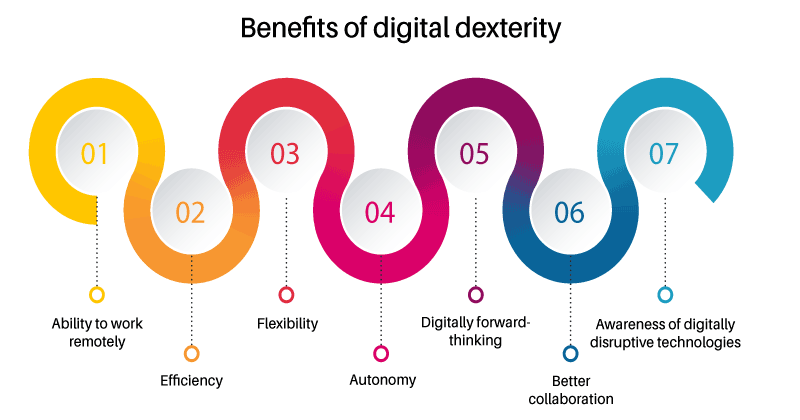
1. Ability to work remotely
There were a lot of changes that took place due to the pandemic, and one of them was the increased emphasis on remote work. Many people around the globe had to adapt to the sudden change and work remotely, which was definitely easier for those with digital dexterity. Working remotely requires individuals to have a firm grasp of the tools and processes involved in finishing work and robust communication methods within the teams. This required a high level of digital competence and dexterity to succeed.
2. Efficiency
Digital tools can greatly boost efficiency in the workplace, especially if you are well-versed in how to use them. This can be seen in employees who have a firm grasp of the features available in certain software and how they can be used to boost the overall productivity of themselves and those around them.
3. Flexibility
Generally, when employees are hired for a certain job, the roles and responsibilities given to them can be quite rigid. With digital dexterity, employees are better equipped to handle duties outside their scope, allowing them to experiment with different roles and tasks. They can find new roles and positions that can make full use of their skills using different tools and software.
4. Autonomy
A digital-first approach can give employees more autonomy over their actions and the methods in which they tackle issues. Digital dexterity can help individuals become more independent with tools that can help them achieve shifting targets with their teams.
5. Digitally forward-thinking
If an employee is aware of the digital landscape, they are more likely to look for tools and platforms to increase work efficiency. This can open up opportunities to utilize better features that can give your company an edge over its competitors.
6. Better collaboration
Digitally dexterous individuals can communicate and coordinate with their peers faster and more easily through digital tools designed to solve these problems. Tools like Slack, Google Meet, and Skype have all proved useful in encouraging better communication, and your employees will constantly be on the lookout for better tools if they have digital dexterity.
7. Awareness of digitally disruptive technologies
Digital dexterity also promotes a better understanding of disruptive technologies like AI, Machine Learning, RPA, etc. This can lead to them thinking of unique ways to utilize these innovative tools and adding value for your customers.

How can you achieve digital dexterity at your workplace?
It’s important for companies to include digital dexterity in their requirements for skilled employees. They should also focus on training their current employees to achieve the digital know-how that is required today. According to Gartner’s analysis, employees who are highly skilled in digital capabilities are 3.3 times more likely to efficiently and profitably finish digitalization projects compared to a workforce with only moderate digital dexterity. It has become even more important for organizations to insist on this. If there is a cultural change, there is a better chance that employees can be encouraged to adopt new ways of working and new solutions without much resistance to change.
Here are 9 points to follow when encouraging digital dexterity at the workplace:
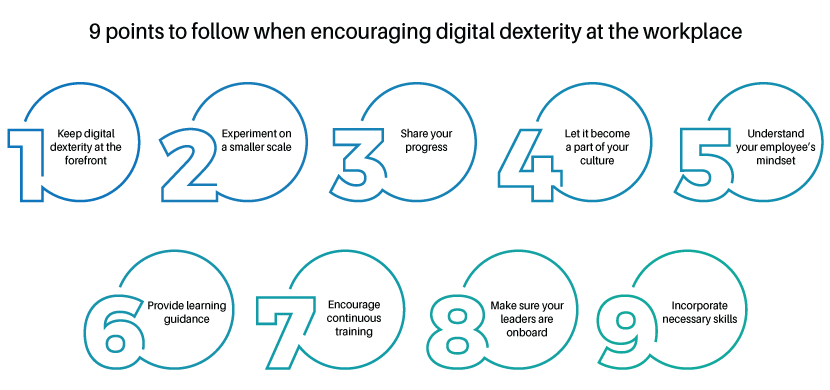
1. Keep digital dexterity at the forefront
The best way to successfully integrate digital dexterity into the day-to-day routine of your employees is to keep it at the forefront of your agenda. Developing a strategic plan to help it spread throughout the organization can encourage your employees to begin thinking digital-first.
2. Experiment on a smaller scale
Don’t start on a large scale immediately. Start small with a team or a department and get a good gauge of what it will take to successfully educate everyone about a digital-first approach. Digital dexterity involves employees being aware and ready to embrace new forms of technology that can be hard to implement on a larger scale at once.
3. Share your progress
Once you’ve made sure that your team or department is digitally dextrous, you can share this achievement with your other colleagues and peers. This can help you get in touch with other like-minded individuals and you can work together to spread it to the rest of the organization.
4. Let it become a part of your culture
The best way to make sure that digital dexterity remains a focal point of your organization is to include it in the company culture. Fostering a culture that encourages people to remain vigilant in terms of new opportunities and technologies can help encourage digital competence in the future as well.
5. Understand your employee’s mindset
Your employees are individuals who have their own traits and strengths. This needs to be considered when you start encouraging digital dexterity within your organization. Understanding their concerns or difficulties that might arise when becoming tech-savvy is important to ensure that this endeavor is successful. Offering incentives, rewards, and bonuses could further encourage your employees which can further help in creating a digitally inclined ecosystem.
6. Provide learning guidance
Technology isn’t always easy to learn and that’s why your organization needs to encourage employees to ask for help when necessary. This can be in the form of training programs as well as design thinking courses to help employees learn quickly. Software onboarding processes can also help guide them in the right direction as they become aware of the software and start using it. This guidance could make a serious difference in motivating employees to learn and become technologically knowledgeable.
7. Encourage continuous training
As the tech world evolves, your employees need to evolve with it. With new programs and features being introduced constantly, employees need to be aware of new developments at all times. Continuous training can help bridge this gap and keep your employees updated about what’s on the horizon in the technological landscape. By encouraging your employees to stay updated, they may be able to solve their own problems instead of asking the IT department for help. This can also encourage citizen developers to create whatever they need. A skilled talent pool can help your digital transformation efforts succeed.
8. Make sure your leaders are onboard
Disruptive tools can be found in every industry and leaders need to stay aware of these unique threats. The leaders of business units and other people in high positions need to be aware of threats and also how to combat them using other digital tools. Digital dexterity in the leaders can help encourage employees to pursue particular skills as well as foster communication within the team regarding which tools can help the organization. The digital dexterity of digital leadership landscape might be evaluated on different parameters than the other employees as they have to constantly think of the future as they make decisions.
9. Incorporate necessary skills
Apart from the essential technical skills, employees also need to well-versed in psychology, communication, and social skills. These soft skills can also make a huge difference as it can encourage employees to take risks, collaborate efficiently, and innovate to find better solutions. This can be a big change throughout the organization, and it will make it easier for the HR team to check for any skills that need supplementing among the team members.
Summary
It’s important for companies to seriously think about incorporating digital dexterity into their required skills for employees. This trait can help increase efficiency, boost productivity, and enhance collaboration throughout the organization. It can also benefit the employees individually as well as the organization on the whole. CIOs and HR teams need to work together to get every employee the training and lessons they need to be tech-savvy. A holistic skillset and an openness towards new technology in the employees could help the company prosper and help foster a better culture at the workplace.
With Quixy, you can use our no-code platform to help your teams build the applications they need without asking IT for help and become citizen developers. Get started with our platform, and experience the ease of automated processes and personalized app building.
Login
Please login to comment
0 Comments
Oldest
